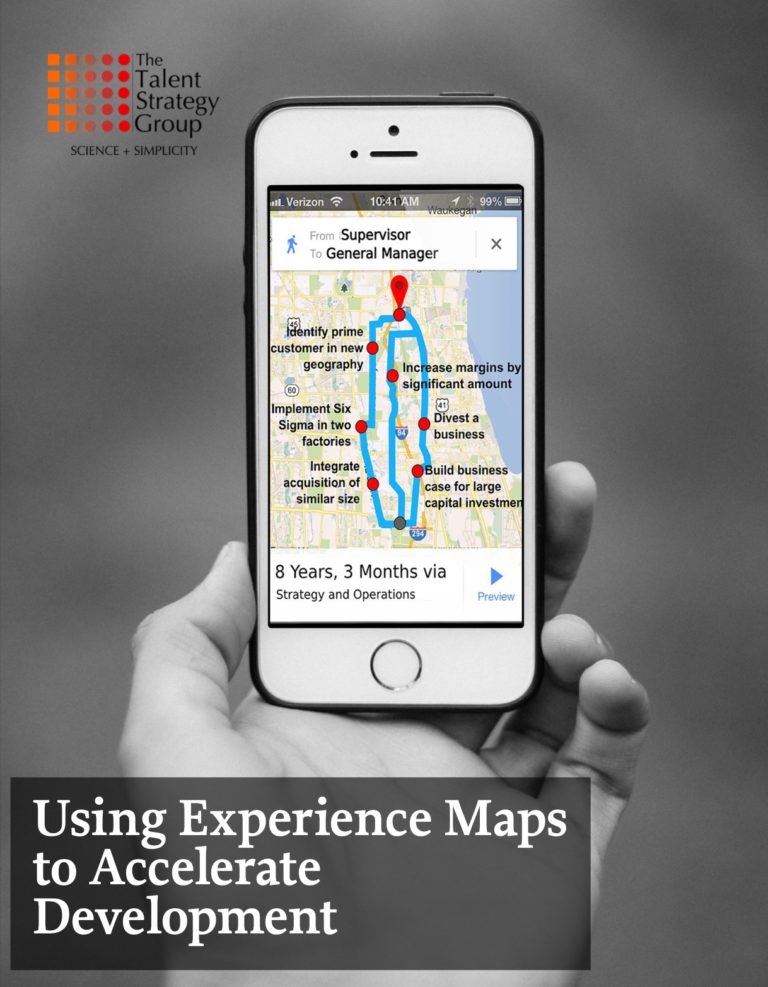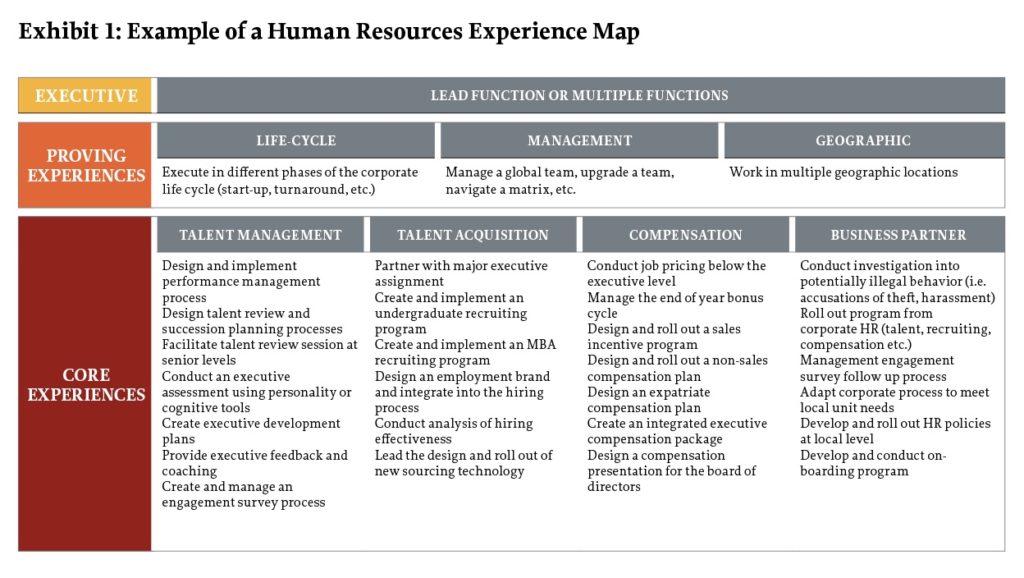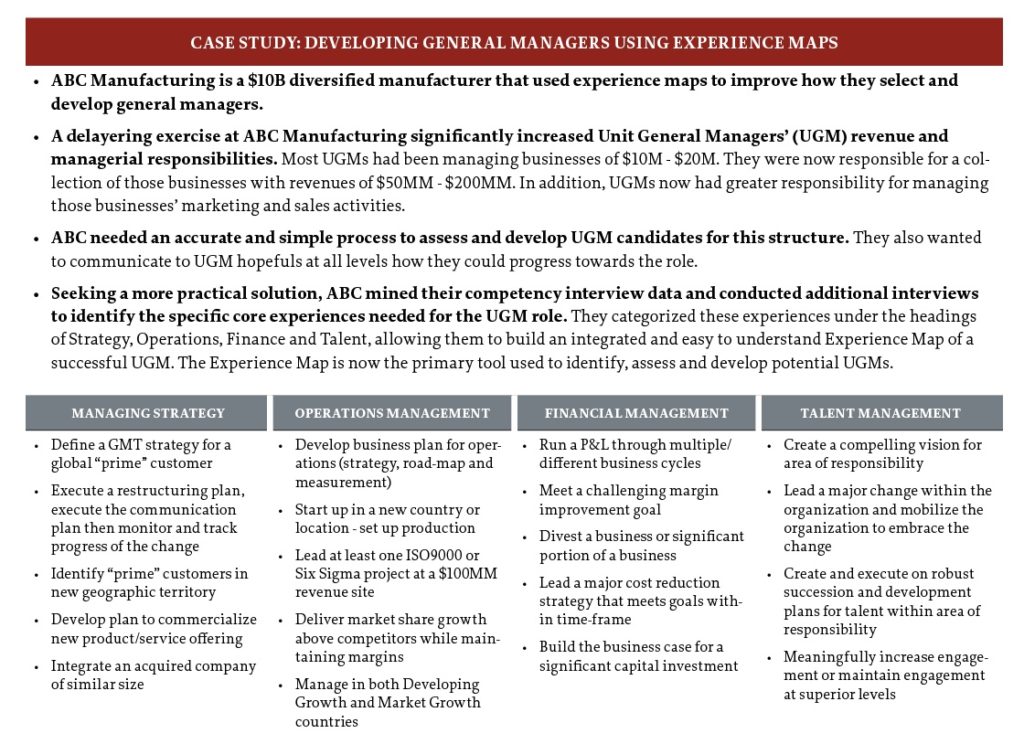Using Experience Maps to Accelerate Development

There’s something for everyone to dislike about how companies develop talent today. Employers are frustrated that expensive learning investments yield questionable results. Managers are frustrated that complex development processes deliver little value. Employees are frustrated that companies provide them with few practical insights about how to grow their capabilities.
These frustrations play out against a back-drop of rapidly changing corporate needs, unpredictable economic cycles and increasingly project-based work that call into question whether companies should invest in talent development at all.
Given these challenges, it may be helpful to reflect on three key facts:
First, we know that better quality talent – especially in key roles – delivers better business results. This implies that there’s potential value in activities that improve talent quality.
Second, we know that our customer – the executive team – wants talent who are available now and proven to be effective.
Third, we know that experiences accelerate development and demonstrate a leader’s capabilities.1 If properly applied, experiences will give our internal customers better talent faster.
Those facts suggest a rather straightforward solution to improve talent development. To get our customers better quality talent faster, give your talent powerful experiences using the most efficient possible process. Simple.
Why Not Skills or Competencies?
Unfortunately, despite widespread recognition that experiences accelerate development, few companies use them as their primary development framework. Instead, managers and employees have been left to struggle with complex and difficult to apply competency models.
More recently, the development conversation has shifted to skill-based development, which further confuses leaders and employees. There are multiple challenges with the skills concept, the first of which is defining what a skill is. A recent Deloitte research paper advocating for skills describes them as:
“(they) encompass “hard” or technical skills (such as coding, data analysis, and accounting); human capabilities or human skills (such as critical thinking and emotional intelligence); and potential (including latent qualities, abilities, or adjacent skills that may be developed and lead to future success).”2
That definition nearly single-handedly invalidates the skills movement by claiming that skills are everything from actual skills to behaviors to personality characteristics to intelligence and more.
Try to explain that all-encompassing definition to a manager and then ask them to create a skill-based development plan for an employee.
Focusing on skills rather than experiences also fails because skills, like competencies, are only a precursor to truly delivering something. Just because you have skills doesn’t mean you’ve proven your ability to deliver value by applying them.
Experiences describe a result you have delivered, not the potential to deliver it based on a set of skills or competencies.
Finally skills, defined in the more traditional sense of “things you’re good at,” are a sub-component of experiences. If you have skills in mechanical engineering, project management and large-scale construction, you can apply those in many different ways.
Demonstrating those collective skills through an experience like “Build a large bridge” is what makes those skills valuable. On their own, skills are just ingredients looking for a recipe.
Whether you focus on skills or competencies, neither approach prioritizes which capabilities are most valuable to the company, so development efforts are often misdirected. They don’t easily fit into a larger career framework, so employees don’t understand how today’s development contributes to future career growth.
In short, typical competency models and newfound skill approaches don’t help managers to accelerate development or provide employees with a guide for managing their careers.
A fundamentally different solution is needed if we want to grow better talent faster.

The Experience Map
An approach called Experience Maps is a far more efficient and easier to navigate approach to accelerate development. Applying the One Page Talent Management mindset, Experience Maps answer the question: What’s the easiest way to help managers and employees quickly develop new capabilities?
An Experience Map accelerates job and career development by defining the specific experiences needed to excel in a role or function. It describes the outcomes that someone must demonstrate to prove competence (i.e. create a business strategy for a $50M unit; bring a factory to ISO9001 standards). A competency or skill model only describes the precursors to that outcome (i.e. is a strategic thinker; understands factory management).
An Experience Map isn’t intended to be an exhaustive list of capabilities or a job description. Rather, it tells you which experiences you should have to prove your capabilities.
For example, a Human Resources Experience Map (see Exhibit 1) shows the core experiences that contribute to being fully competent in talent management, talent acquisition, business partnering and compensation.
After gaining functional depth, the map describes Proving Experiences where a manager demonstrates their ability to apply that functional depth in different scenarios.
In this case, an HR business partner who proved herself successful in a growth environment would be given the same functional challenge in a turnaround environment.
Proving Experiences both assess the manager’s capabilities and allows them to demonstrate the potential to move to more challenging roles. (NOTE: The map shown is an example. Experience Maps should be customized for your organization.)
Why They Work
Experience Maps accelerate talent development because they are:
- Easy to understand: While competencies can feel abstract, experiences are real, tangible and familiar. “Create a strategy for a $50M business” is easier to comprehend than “Increase your strategic thinking capability.”
- Easy to assess: It’s a simple process to evaluate which experiences someone has had and which they need. Given that experiences are tangible and observable, assessing their completion is far more objective than assessing progress against a competency or skill.
- Focused on results: Experience Maps describe actual outcomes that must be achieved, not the behaviors or skills that precede an outcome. As an analogy, Experience Maps describe the finished cake; competency or skill models describe the ingredients.
- Practical career guides: While no guarantees are made, Experience Maps provide specific insights about what’s needed to move up or over in an organization.
- More certain: The human brain craves certainty and predictability – such as knowing the potential paths for career advancement. Stress levels increase as certainty decreases. Making concepts like career progress more explicit can potentially reduce stress and the workplace distractions it causes.
- Removes excuses: Anyone can get an experience or a portion of an experience, so there are no excuse left for people not to develop. If someone else already owns redesigning performance management and you want that experience, you can be on the project team, lead the change management and implementation, etc.

Building Experience Maps
Creating an Experience Map begins with interviewing deep functional experts in each area. Those experts identify the core functional categories and the most important experiences to have in each.
These insights drive the map’s content, so it’s essential that those who provide input are truly experts. If you don’t have functional experts in your company, use a search firm or consulting firm to provide this detail.
Those interviews generate a long list of experiences that is reduced to those with the great power to create functional expertise. Experiences should be phrased in a way that’s specific, achievable and easy to understand. Using 10 words or less to describe them ensures that you’re being succinct.
Supporting Experience Maps
While Experience Maps are a helpful tool, they’re more successful when all of a company’s development activities are experience-focused. Our article Delusions of Employee Development offers six changes that will support implementing Experience Maps.
One key lever we’ll mention again here is to orient your development processes entirely around experiences. Examples include turning your Individual Development Plans into Individual Experience Plans and requiring two-up approval for any development activity that isn’t an experience.
Managers and employees should meet to review the Experience Map and discuss which next experience makes the most business sense to pursue. It should be the manager who makes the final decision about that experience. This avoids the pursuit of unrealistic career goals or activities that aren’t aligned with core business needs.
In Search of A New Solution
We know that better talent delivers better business results. We know that critical skill gaps exist that leave millions of well-paid, high-skill jobs unfilled. Unfortunately, the well-intentioned complexity of competency and skill solutions renders them largely useless in addressing these opportunities.
Experience Maps provide a practical alternative for accelerating talent development. Easy to understand and easy to apply, they may be the answer to the talent development challenges that are constraining corporate growth worldwide.
As a talent executive recently told us, “I’m blown away by the quality of development conversations that leaders are having. All we did was shift the conversation from ‘what development do you need’ to ‘what experiences do you need’ and it’s made all the difference in the world.”
References
- McCall, Morgan W., Michael M. Lombardo, and Ann M. Morrison. Lessons of experience: How successful executives develop on the job. Simon and Schuster, 1988.
- The skills-based organization: A new operating model for work and the workforce, retrieved 11/2/22 at https://www2.deloitte.com/us/en/insights/topics/talent/organizational-skill-based-hiring.html